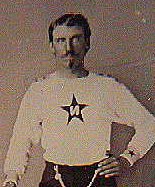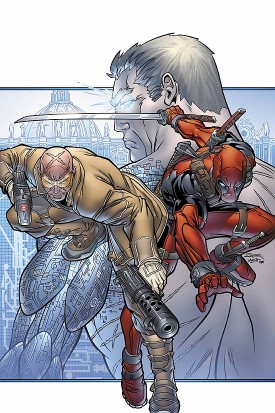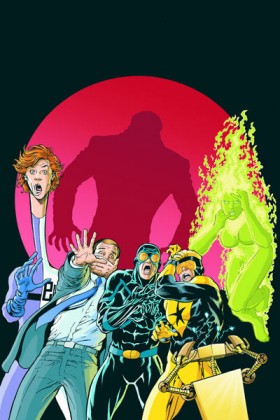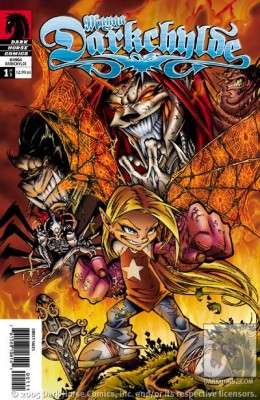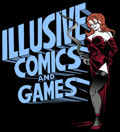|
|
|
|
Jason
Schachat wanders the Earth in a radioactive suit
of armor.
|
Jason
Schachat's Weekly Breakdowns
February 24, 2005 For
anyone desiring a little of Peter Bagge’s special
brand of angry cartooning, the creator not-quite-proudly
presents us with Apocalypse Nerd #1.
Answering that age old question of what would happen if
a Microsoft programmer had to survive in the woods following
the nuking of Seattle, this miniseries tells the tale of
Perry and Gordo’s camping trip gone wrong.
While driving out into the Cascade Mountains,
the two losers talk about their failures either with women
and the job market. As they tweak the radio, hoping to catch
a sports broadcast, they pick up a staticky signal that
the National Guard have been summoned to deal with some
kind of disaster.
Weaving away from cars rushing in the opposite
direction, they come to a convenience store where the owner
sits behind the counter with a rifle trained on them. Why?
‘Cause Kim Jung Il got a little whacky and decided
the Space Needle would look better as vapor over a pile
of ash, duh!
Bagge’s style of writing and drawing
harkens back to the time of underground comics, and, as
such, suffers a little when serialized as a longer story.
As with many cartoonists, his rubberband-limbed characters
tweak the narrative in an oddball direction, no matter what
point they start from. In this case, Perry’s overwhelming
fear of damn near everything gives the rather slow-moving
story a manic tension.
However,
the limited plot starts to drag by the end of the issue
and leaves us with no idea of where the series is heading.
Just for Bagge’s quirky style, I could recommend Apocalypse
Nerd, but the story itself doesn’t have much
to offer. It makes for a nice distraction, but there isn’t
enough meat here to satisfy most readers.
What
is it that makes Cable & Deadpool work so well? Honestly.
I’m genuinely ashamed to be enjoying this book as
much as I do, and, having reached Cable &
Deadpool #12 without once rolling my eyes
or clutching my abdomen in non-laughter induced pain, I
have to wonder when this crazy train will run out of steam.
Previously, Cable had become the new messiah,
bonded with Deadpool in a physical sense beyond any which
two men have ever known before, and then practically got
himself killed when the Silver Surfer thought his crusade
might doom the Earth. Cable’s solution? Have Deadpool
give him a lobotomy to keep his off the scale psychic powers
from growing beyond human morality (cheesy and melodramatic
as it sounds, it seemed like a good idea at the time).
But now Deadpool misses the flashy-eyed
galoot and wants to resurrect him by bonding a world-devouring
biomechanical alien doom baby to what’s left of Cable’s
body and mind. Unfortunately, some parties don’t like
that idea and have hired Agent X to prevent Deadpool and
The Fixer from saving Cable. Meanwhile, the tea party inside
Cable’s mind continues as he cheerfully tells the
new Six Pack team who had come to kill him they’re
doomed unless Deadpool can get everything back together
and fix him.
So they’re doomed.
Cable
and Deadpool’s relationship goes all the way back
to the original New Mutants, but I don’t
remember it ever being as enjoyable as this. Hell, I don’t
remember Cable really being enjoyable at all—but,
cut free of Rob Liefeld’s disabilities, Fabian Nicieza’s
action-packed, cheap joke-filled story has gone far beyond
his work on X-Force.
Patrick
Zircher’s art blends explosive action, cartoony antics,
and epic grandstanding in a way that Liefeld’s never
could. The goofy Alice in Wonderland inspired dreamland
for Cable’s tea party is a perfect example of the
versatility that makes this title’s manic humor work
(especially when it comes soon after Deadpool viciously
disembowels Agent X and uses the entrails to spell out a
message to friends watching the action from a nearby balcony).
Why
does this work? What makes Cable & Deadpool
succeed where so many of Nicieza’s projects have failed?
I have no idea. It may be the same b-list mocking formula
that made Justice League International sing back
in its day (more on that later), only geared for shorter,
more bloodthirsty, attention spans. But, hey, it works.
Recommended.
Though
I may write endless praises of The Walking Dead, the rest
of the zombie genre has mostly been a walking disaster that’s
plagued comics for years, depositing a few trite attempts
on us every year. Damn Nation #1
is one of these attempts. Working like an American 28
Days Later, this stale little title plods along without
telling or showing the reader much of anything.
Things start going to hell when a Soviet
freighter, lost at sea for 16 years, floats into Miami harbor.
Homeland Security dispatches a biohazard team to investigate
the strangely radioactive vessel and discover hundreds of
naked corpses strewn about the vessel. Then the corpses
come to life.
Five
years later, the President lives in exile in London, and
the U.S. seems to be teeming with zombies. But, just when
things look hopeless, a message comes in from a research
facility on Buffalo, New York: “We have the cure."
Now, contrary to what this summary may suggest,
readers will have to weed out many of these facts from the
poorly paced and unfocused narrative. Like the murky artwork,
you kind of have to squint to see just what’s going
on, and rushing through it will leave you confused. Though
J. Alexander’s paintings have a lovably filthy charm
about them, too much of the photo referencing devolves into
trite, Xeroxed photo art. Especially in backgrounds.
And,
while I’d never suggest a zombie book needs to be
filled with action scenes, it always helps to give the reader
something exciting. Damn Nation is neither exciting
nor scary. Kinda creepy, yeah, but it’s so completely
devoid of characterization that we don’t give a damn
if anyone lives or dies. The fact that we don’t really
get to see the zombies also tones down the threat level.
Add
to that the ridiculous notion that a Russian freighter filled
with plutonium bound for Lithuania somehow bypassed all
known currents and somehow landed in Miami — WITHOUT
the U.S. taking a bite out of Russia’s ass for turning
the Land of the Free into a free range zombie farm…
well, you just can’t take it seriously, no matter
how grim and gritty the art is. Pass on this one.
They
say sequels never live up to the original, and this seemed
to be the case with Justice League International
and the reunion party that was Formerly Known as the
Justice League. Sure, it won an Eisner, but it didn’t
represent the best that JLI achieved. JLA
Classified #4’s “I Can’t
Believe it’s not the Justice League” does. Oh,
man, does it ever.
With minimal exposition to acquaint us with
the Super-Buddies (as they’re now called), this first
issue thrusts us into a new conflict: a former supervillain
is building a bar next door to our heroes’ HQ! Sue
Dibny does some research online and discovers the fiendish
Blackguard (feel free to scratch your head and say “Who?”)
is setting up shop on their turf and immediately starts
chewing out Elongated Man and Maxwell Lord, thinking they
should punch him in the nose or something.
Elsewhere, Blue Beetle and Booster Gold
trade backhanded compliments on each others’ new costumes
(their first new costumes ever *gasp*) and discuss Fire
and Mary Marvel’s plans to room together. Then Beetle
changes the subject to Booster’s geriatric spouse.
Meanwhile, Fire decides to take a break from house hunting
and introduce young Mary to the tingly joys of coffee. Lots
and lots of coffee. Bad idea.
Formerly
Known as the Justice League tried to bring the old
crew together in the traditional “all the old enemies
are back in town” fashion, more or less, and that
just didn’t work for me. The humor got pushed to one
side, and Blue Beetle and Booster Gold didn’t come
up with any get-rich-quick schemes or even have that much
interplay. The best issues of JLI were always more
about the characters than the situations they were in.
With “I Can’t Believe it’s
not the Justice League”, the characters take center
stage while a weak external conflict repeatedly tries to
push its way past their constant infighting. Naïve
Mary Marvel makes the perfect foil for the worldly Fire
(R.I.P. Ice), Booster and Beetle are acting like Abbot and
Costello again, Sue and Ralph are far more amusing than
in their JLE days (R.I.P. Sue), and lovable robot L-Ron
is more obnoxious than ever.
Better still, Giffen and DeMatteis have
cleared away the cobwebs and gotten back into the old groove.
The first jokes build from harmless annoyances into beautifully
structured gags that will have you in stitches. The timing’s
perfect, and Kevin Maguire’s grasp of expressive faces
is flawless as ever. Toss in some great coloring, and you
have one of the better looking and, undoubtedly, funniest
books of the year. And, yes, even newbies will love this
one. Very strongly recommended.
Crushing
as it was to see Andi Watson’s Love Fights
prematurely end after only a year, Little Star
#1 doesn’t start off the new bi-monthly
with the same striking storytelling that’s made his
other works so enjoyable. There’s something to be
said for subtle beginnings, and Watson may very well be
the master of subtlety, but this book gives us very little
plot and hardly any reason to keep an eye out for the next
issue.
It opens
with Simon, our main character, hurtling out of the solar
system, identifying planets and moons as he drifts into
the inky blackness. Then he wakes up. To the sound of his
daughter crying out in the middle of the night. Not crying
for him, but calling for “Mummy.” As we follow
him through his day, we see this is not merely a bad habit,
but her outlook on life: if you’re not a woman, you
can’t be as good as Mummy.
Simon
drops her off at daycare and heads off to his part-time
job detailing china plates, reminiscing on how he used to
be a specialist who painted the fine porcelain figurines.
Of course, he gave that up hoping for more variety and more
time to spend with his daughter. When asked what he wanted
to be when he was a kid, Simon first remembers a love of
Star Wars that made him want to be an astronaut,
but then recalls a desire to be a mechanic. A longing for
a job where things either work or don’t, unlike his
current job as a father.
Watson’s
been putting out great slice-of-life comics for a while,
but he’s demonstrated in the past how hard of a sell
these quiet, low-plot stories can be. Little Star
feels almost like a sequel to Breakfast After Noon
(and may be, considering the appearance of a man named Rob
who bears quite a resemblance to the aforementioned book’s
main character); it moves the notion of a bread-winning
wife and a stay-at-home dad from an ending into whole new
set of problems.
But,
like Breakfast After Noon, the first issue slips
us into the main character’s life without giving us
much reason to want to follow him. Watson does a great job
of introducing Simon and his situation, but the conflict
is so broad yet subtle that it almost doesn’t feel
like a conflict at all. Worse yet, the ending of the issue
makes this feel like a sleepy oneshot rather than the opener
for a new miniseries. Watson fans may go for it, but I’d
advise anyone new to his works to start with Geisha,
Slow News Day, or Love Fights before visiting
this title.
|
|
|
Pretty
average kid, actually...
|
Manga
Darkchylde #1 re-imagines the Darkchylde character
in… wait for it… a manga style, portraying her
as a young girl fighting mystical forces of evil. Having
never read any Darkchylde, I could only guess the
main character was getting a treatment similar to Marvel’s
Mangaverse experiment. Truth be told, it’s even less
“manga” than that.
Darkchylde opens the issue by narrating
her current state of mind, and continues to do so through
the final page. Apparently, she has the power to become
any sort of hellish monster you can imagine and use its
powers for her own purposes. But there’s a catch:
if she abandons the form of the beast, it’s free to
wander the earth and do as it pleases.
When
her next door neighbors’ house lights aflame in the
middle of the night, she panics and becomes a werewolf to
save them from the blaze. Afterwards, she leaves the monster’s
body and it trods off into the woods, looking for something
to maim. Luckily for Darkchylde, she can also absorb simple
powers from her monster menagerie and conveniently use them
to hunt down her enemies. Not so convenient for the wolf,
but it sure is better than bringing another beastie into
the world, though not necessarily safer.
Despite
what the creators of Manga Darkchylde may think,
this is hardly what I’d call manga. The paneling’s
too loose and sloppy, the pacing gives us no quiet moments
to reflect on, the action scenes are completely western
in staging, and the character designs aren’t remotely
Japanese (except for the exaggerated eyes on small children).
That said, the art isn’t bad and the production’s
pretty enjoyable, but it doesn’t feel too different
from the old Image style.
The
story provides a nice starting point, but that’s about
it. All narrative is sacrificed for style, and, in the end,
it’s not really worth it. People looking for another
pseudo-manga that’s low on story might get some thrills
from Manga Darkchylde, but it’ll leave true
manga enthusiasts baffled and wanting.
We get
another changing of the guards this month in Tom
Strong #31, as Michael Moorcock and Jerry
Ordway take the reigns and lead Tom’s crew back in
time for some piracy on the high seas. It may not be Alan
Moore’s baby now, but the spirit of adventure is still
going strong.
Part
one of this two-issue arc finds Tom’s home of Millennium
City being battered by the worst storm in its history. Trusty
ape companion Solomon King patrols the metropolis in one
of Tom’s helicopters and notices a rather out of place
zeppelin parked outside and English pub. Upon further investigation
he finds that, indeed, in the pub there is an Englishman
who piloted the zeppelin — from the future.
He tells Solomon that his time travel is
responsible for the tempest that’s thrashing Millennium,
but far more is at stake than the well-being of one city;
his nemesis Count Zodiac has set into motion a series of
events that may very well ruin the whole multiverse. Their
only hope is for Tom Strong and Solomon to travel across
dimensions and stand-in for alternate versions of themselves
who joined Zodiac’s pirate fleet.
Truth be told, I’m still not entirely
happy with Tom Strong’s evolution from a bold Alan
Moore experiment to a showcase title. True, the teams to
take over the book have all done good jobs, but none of
it has lived up to the larger arcs that defined the series
and made it so wonderfully addictive.
In this instance, Moorcock and Ordway masterfully
set up the story, but let the excitement fade somewhere
around the middle. Granted, there’s a lot of plot
movement for a single issue (in these days of hyper-decompressed
storytelling), but it all feels rather rapid and not as
rich in detail as one might hope.
However, it’s the first issue in quite
a while to recapture that extended Golden Age feel Tom Strong
is famous for, delivering a tale without any damaging elements
of present day storytelling. It makes you wonder what they’d
be able to do given more issues… While I may have
some reservations, it’s still worth recommending.
Wolverine
#25 brings the “Enemy of the State”
story arc to a close with a one-two punch that’s sure
to change the status quo (which makes sense, since that
seems to be writer Mark Millar’s new calling). Wolvie’s
rampaged through high security military installations, the
Fantastic Four’s Baxter Building HQ, and even Matt
Murdock’s brownstone, but now he brings the killing
spree to the Xavier Institute.
Having learned of Hydra’s plans to
assassinate the President, S.H.I.E.L.D. forces cordon off
Washington D.C. while the Avengers act as personal guards.
Meanwhile at Xavier’s, they’re still on high
alert following Hydra’s brainwashing of superheroes
all around the U.S. Kitty Pryde and Rachel Summers lounge
in front of the TV and catch us up with a little exposition
before Kitty heads off to bed and leaves Rachel alone.
Alone except for the “cloaked”
Wolverine sitting on the couch cradling a primed nuclear
device, that is. As it turns out, Hydra’s plan for
taking out the Commander in Chief was even more artful than
first suspected; Wolvie’s just going to plug Rachel
into Cerebra and have her give the Pres a massive brain
hemorrhage. If she doesn’t do it, Wolverine nukes
the school.
At its best, this story has harkened back
to Frank Miller’s work of the early ‘80s. The
rough yet dynamic pencils, Klaus Janson’s sloppy inks,
the throwback outfits on nearly every character, Wolverine
in Japan, piles of dead Hand ninjas; it was practically
a timewarp. And, looking at the end of this issue, the journey
is far from over.
Mark Millar’s done another magic act
of tossing characters into bizarre and risky situations
and shaking up a big Marvel franchise. The deaths that occur
in this issue may force Wolverine continuity to finally
match-up, and Wolvie’s new vocation, however temporary,
will be a lot more fun to follow than the tepid attempts
at ronin wanderings.
I will confess that this issue isn’t
quite as pleasing as the last couple were, but that may
just be my weakness for seeing Elektra and Daredevil slaughter
legions of ninjas. The body count’s far, far lower,
this time, but the impact should be a lot more lasting.
Recommended.
Hot
Predictions for This Week: Batman #637, Conan #13,
Fantastic Four #523, Sleeper Season Two #9, and Ultimate
Nightmare #5.
|
